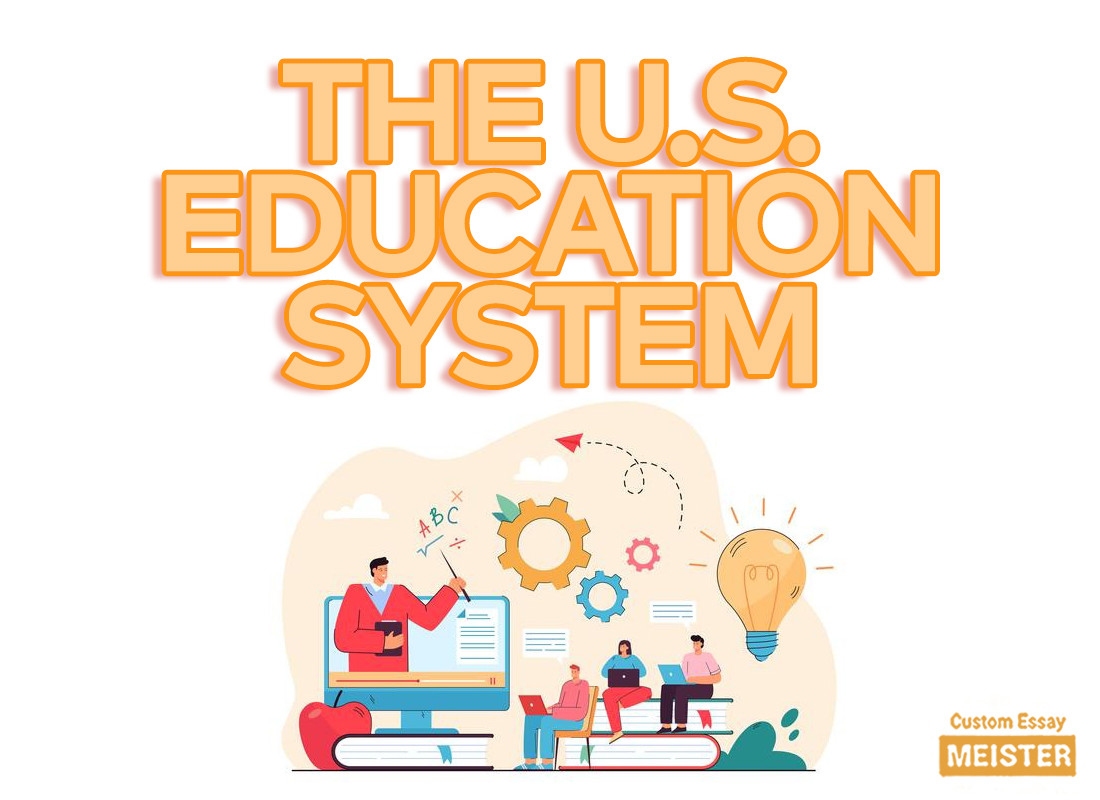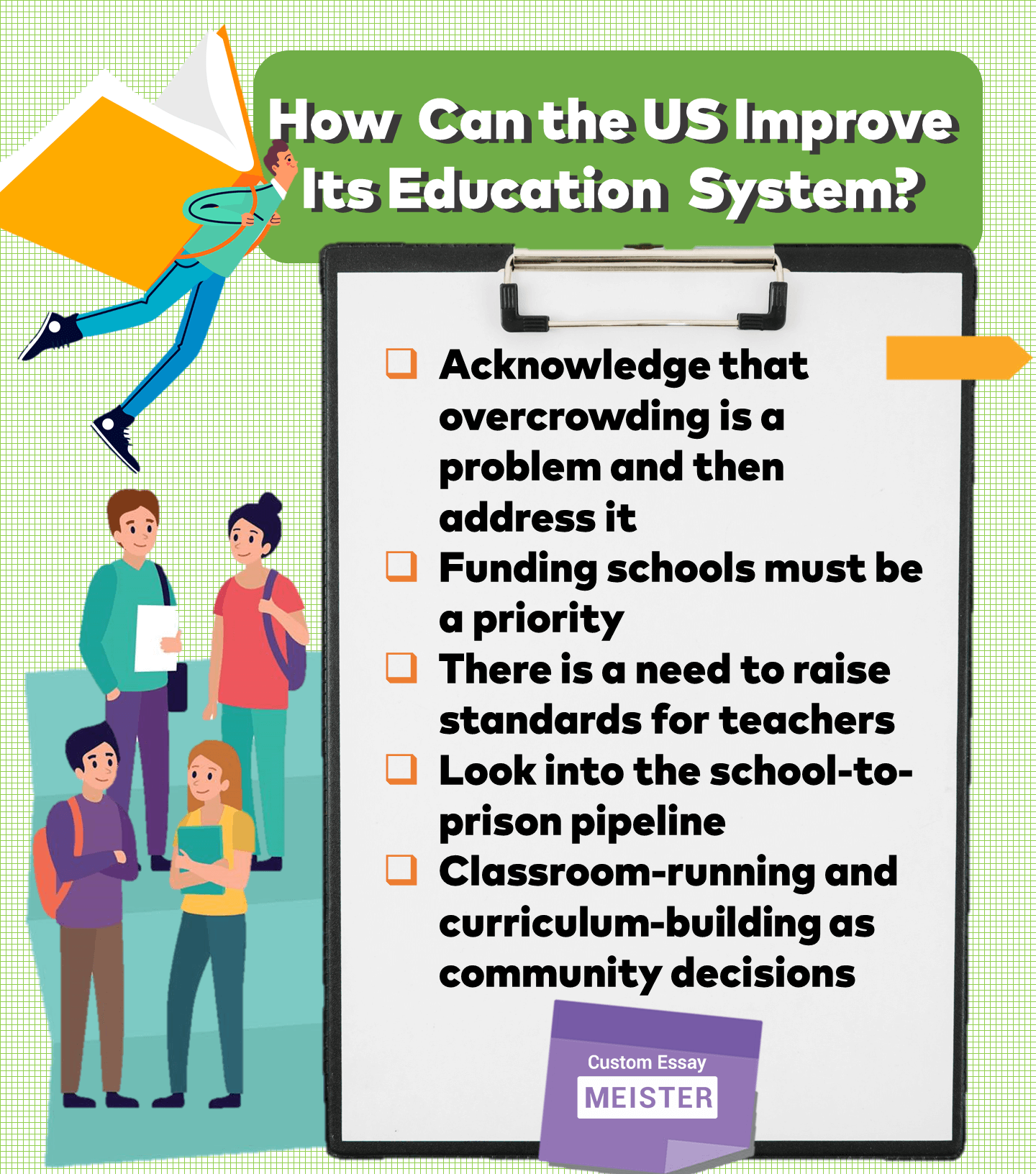15% discount on first order.
Special Welcome Offer.0
days00
hours00
minutes00
secondsHow Can the US Improve Its Education System?

Lo and behold, the land of the free . Where dreams are just waiting around the corner, and to get to them you need only believe. Immigrants and natives alike have sowed the soil, and success through the American Dream has been deemed for everyone – but when it comes to the educational pathway towards the said goals, the news is disappointing. The quality of the US education system is a fright to see, and dreams deteriorate right before people’s eyes. The Organization for Economic Cooperation and Development (OECD) released a global ranking of educational systems and student performance in subjects like math, reading, and science in 2015. The ranking was based on the Program for International Student Assessment, an examination given around the world every 3 years, designed specifically to assess 15 year old students from 72 countries. In terms of education outcomes, the United States suffered significant point drops in math scores, and its students only scored an above average in reading and science.
How can the US improve its education system? Debates surrounding it are endless, and almost always end in fraught. The issue is indeed a complicated one, and on top of it all, comes with extremely high stakes. However, this should not discourage policymakers from engagement. In fact, the very system of education relies heavily on policy, and if change is desired, policymakers should rise up and take the challenge. In spirit of trying to understand where to begin, below are some issues lawmakers and officials can take a look at.
Acknowledge that overcrowding is a problem and then address it
The National Center for Education Statistics conducted a study, where they found that 14% of US schools exceeded maximum capacity. The problem mostly affects low-income and minority students, miserably cramped in public schools. Sadly, the issue of overcrowding is not a new one, as almost three decades ago, in 1990, a study in New York state found that overcrowding is linked to lower achievement of students coming from low socioeconomic backgrounds. Both teachers and students from the study felt discouraged and overwhelmed at the circumstances, as well as disgusted, from the results of overcrowding. Teachers also report lack of resources, including space and materials. They are forced into less than ideal conditions, with lessons being taught outside of classrooms such as gymnasiums. This leads to heightened levels of stress in both students and teachers.
Overcrowded classrooms have been shown to be less effective time and time again, as teachers are spread thin. Students also lose interest, as they do not get the attention they may require – this plants seeds for dropouts.
Policymakers, then, are encouraged to address this problem by crafting master plans that have no room for even a sliver of overcrowding. The process is tedious, as it must be ongoing and maintained properly. Developments of new structures is needed, along with hiring more qualified teachers.
Funding schools must be a priority
There are statistics around school funding in the United States, and the results are sobering. States contribute 44% of total education funding in the US, and the Center on Budget and Policy Priorities reports that over 34 states channel less funding into education. Between the years 2008 and 2016, local school districts cut a net total of 297,00 teaching jobs. The problem is more than just a matter of cash flow or the federal government struggling to find revenues – it is actually a priority issue. Take this for instance: every state in the country spends more to house inmates than it does to educate an elementary student.
A massive shift in priority should be considered, which can happen through the implementation of a progressive tax code. Perhaps federal government can look into taxing corporations and wealthy citizens their due, and by doing so, a healthier education system can be funded. Another suggestion is to simply just increase funding for teachers and extending support. Educational funding should be more than just building new schools and improving older buildings. An increased funding for teachers, specifically in low-income areas, can help boost quality. There is a tendency for teachers to seek work in more affluent areas because of better pay and working conditions, so the quality of teaching in poorer schools suffers immensely. If there can come a solution for attracting and retaining teachers in such areas, students desperate for quality education will be able to receive improved education and teaching quality.
There is a need to raise standards for teachers
Unsurprisingly, studies have discovered that underqualified teachers are directly linked to poor student outcomes. Although an issue, the good news about this is that this is one of the most straightforward factors where policymakers can easily make an impact. Standards for teachers seeking to get licenses must be looked into, and those standards must be raised accordingly – that is in areas where student outcomes are the poorest. The Every Student Succeeds Act (ESSA) has abolished the “High Qualified Teacher”, which means that the federal government is less involved with teacher evaluation and licensing. The power is given to individual states instead, where they can ensure the bar is raised for teacher certifications.
Look into the school-to-prison pipeline
Statistics show that more than half of African-American young men who have attended high school in urban areas do not earn diplomas. What’s shocking is that nearly 60% of these dropouts end up going to prison at some point in their lives. This issue, referred to as the school-to-prison pipeline, is so complicated that it affects so many young African American men. They go through in-school arrests and zero-tolerance policies, which include harsh punishments – all these root to the 1999 Columbine shooting.
These disturbing patterns are now being openly discussed, but the issue is severe that it needs concrete actions. Restorative justice may be the answer, as well as efforts to keep the youth away from a flawed justice system whenever possible. A firmer emphasis on other methods of discipline can lead to significant improvement in retention, as opposed to solely relying on detention and suspension. One case reports that a high school district located in California focused on restorative justice as means of conflict resolutions, and the number of expulsions reduced from 1,096 to 66 in four years.
Authorities should also look into building a school community promoting inclusion and acceptance. The reality is that schools now focus measuring their success on overall student achievement, and those students who bring down that number are more likely to be forced out, or worse, ostracized. Schools should focus on the development of curriculum instead, and classrooms should prioritize each student’s individual progress. A school environment promoting compassion and understanding is less likely to rely on police officers, school guards, and zero-tolerance policies. All of these contribute to a hostile environment, which stunts student growth.
Classroom-running and curriculum-building as community decisions
In decades past, the education system slowly moved away from local boards and teachers. The role of decision-maker has been placed into the administration, and student outcomes have suffered terribly. Policymakers should look into this pattern, and promote a community-based mechanism, where standardized control should be eradicated. Community-elected school boards should be given the authority to make decisions instead, especially since the manner which their students will be educated is part of the vital equation. Involving parents in their children’s education whenever relevant can also contribute to a student’s success.
What happens now?
How can the US improve its education system? Concrete answers remain to be seen, as the issues that lie within are deeply rooted, all up in a mess of tangles. However, policymakers hold the power to change, and the first step towards this is people coming together with clear messages. The true power lies in the people. Finland has the best education system in the world, and their key secret is continuous collaborative effort between the people and the government – and of course, their attitude towards education. As long as people remain adamant about the changes that wish to see in their education system, particularly that integral aspect of it benefiting all students from every background, change will come. This certainly makes for a good reaction paper, eh?
Essay writing service for students
Feel as though your workload is too much? That may be the educational system’s doing, but fret not – it is completely acceptable to ask for help. CustomEssayMeister was designed for students like you, in need of assistance – writing is not just for everyone. From personal essays, presentations, poems, and dissertations, our writers are ready to help, guaranteed to deliver professional and quality work.
